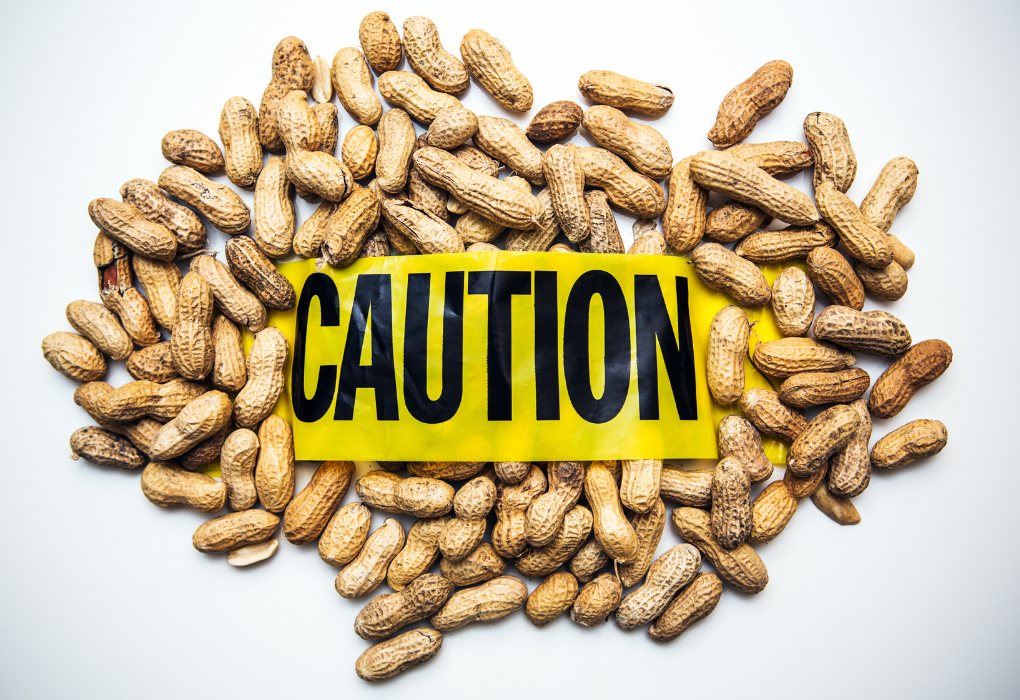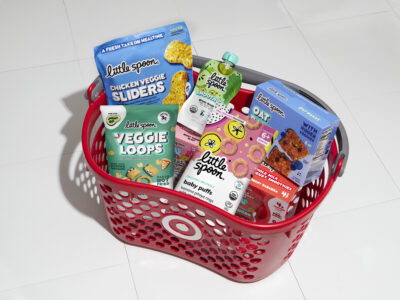By Dr. Taylor Lin, Pediatric Allergist, Immunologist & Advisor at Bébé Foodie
When and Why to Introduce Peanuts
It was not long ago that we recommended infants intentionally avoid peanuts or other allergens until they were older. Now you’ve likely heard that infants should have peanuts, and other allergens, in their diet early and often starting by age 4-6 months. So what’s changed? In 2015 a landmark study by DuToit and colleagues called “Learning Early about Peanut Allergy (LEAP)” was published, which showed that in higher risk children (severe eczema and/or egg allergy) introducing peanut in the diet between 4-6 months of age significantly reduced the risk of developing a peanut allergy compared to children who first had peanut at age 51. This was the first time we have found a strategy to prevent children from becoming allergic to peanuts.
We know food allergies are on the rise, and after the LEAP trial we have a method to prevent peanut allergies. This strategy is called early introduction. Following what was done in the study, it is now recommended by allergists and pediatricians alike to feed your infant peanut for the first time between 4-6 months of age. Not only is trying it once important, but the child must continue to eat it regularly in their diet to maintain that protection against developing an allergy. I’ll share with you how I approach this with the infants I see in my practice.
How to Introduce Peanuts to Babies
Once your child is showing signs of readiness for solid foods, peanuts should be the first allergen to add to their diet. This should be done after they have tolerated other starter foods such as fruits, vegetables, or grains. A helpful step-by-step guideline for the first introduction of peanut is provided by an NAIAD expert panel2.
- Pick a day when your child is well, without illness
- Give the first peanut feeding at home, not at daycare or a restaurant
- One adult should be available to care for the child in case of a reaction
- Spend at least 2 hours with your child after eating the peanut to watch for any signs of allergic reaction
- Prepare a full portion of peanut (see below) but feed only a small amount – size of the tip of a spoon
- Wait 10 minutes. If your child is well (no rashes, irritability, vomiting, coughing) then offer the rest of the peanut at your child’s usual eating speed
In my practice, I give patients these tips for peanut introduction:
- Peanut powder or peanut flour
- Mix 2 teaspoons of powder into yogurt, rice cereal, infant oatmeal, pureed fruits or veggies, mixed with breast milk, formula
- Peanut puffs (e.g. Bambas brand)
- Mix 21 Bambas with water to create a thin paste (thin enough to drip off the spoon to prevent choking)
- Peanut butter
- Mix 2 teaspoons with warm water to thin the peanut butter (thin enough to drip off the spoon to prevent choking)
- Can mix with applesauce or puréed fruits and veggies, or eat plain
Once you’ve had a successful first introduction, serve your infant peanut three times weekly for best prevention. Remember, do not give your child whole or partial peanuts as this is a choking hazard. Wait until they are at least 5 years old to give them whole nuts. Do not give your child peanut butter directly either. Wait until they are at least 4 years old to give them thick nut butters.
Signs of Peanut Allergy
Infants can show us clear signs of having an allergic reaction even though they cannot use words to tell us. Signs you should be watching for include rash (hives) on the face or body, swelling, scratching their skin, scratching their tongue, pulling ears, rubbing eyes, becoming very irritable or clingy, gagging or vomiting, coughing or having difficulties breathing, runny nose, sneezing, or tired/difficult to wake up3. If any of these signs are seen, stop feeding the baby the peanut immediately and call for medical help.
Testing for Peanut Allergies
If your child has a reaction to peanuts, they will need to see a pediatric allergist. About 2% of children in the US have an allergy to peanut4. The allergist will perform testing, either blood testing or skin scratch testing, to evaluate for a peanut allergy. There are instances where a rash was not actually from the peanut at all, and testing can help clarify this. There are also instances where the testing is inaccurate. This is why having an experienced pediatric allergist evaluate your child’s reaction history and their testing is paramount for an accurate diagnosis.
Preventing & Manage Peanut Allergies
If a peanut allergy is diagnosed, your child’s pediatric allergist will discuss treatment options with you. The mainstay of treatment is avoidance – meaning strictly avoiding peanuts in all forms and all amounts. This requires parents to read all food labels before the child eats the food. Even small amounts of peanuts in food can be enough to trigger a reaction in some highly-allergic patients. All children who are allergic to peanuts must have access to an epinephrine auto injector which they will use if they accidentally eat peanuts and have a severe allergic reaction (also called anaphylaxis). Another option for treatment is oral immunotherapy (OIT) which is a treatment course that trains the child’s immune system so that they are only allergic to peanuts in very high amounts. This acts as a safety measure to prevent them from reacting to peanuts when ingested in smaller amounts. Unfortunately, OIT is not a cure for food allergy, but is available to help prevent accidental reactions. Finally, there are numerous studies being performed looking at other treatments including patch treatment, injectable medications, and more.
Common Misconceptions
There are a lot of scary misconceptions about food allergies that my patients and their families face. One misconception I encounter frequently is airborne peanut allergy. There is no scientific evidence showing airborne particles of peanuts causing allergic reactions. Peanut protein is too large and heavy to hang in the air and cannot travel distances through the air. The only exception is if peanuts are being fried and the child is standing over the frying pan, as the oil can spray and cause a reaction if it ends up in their eyes, nose, or mouth. But patients do not need to be scared to travel on planes or be in other enclosed spaces where peanuts may be. They must avoid touching the peanut or eating the peanut, and other children/adults eating peanut should wash their hands with soap and water before touching the allergic child, but there is no risk that a reaction can occur through the air alone. In fact, I bring some children to my office for exposure challenges. After explaining the procedure and obtaining consent, I open a bag of peanuts or a jar of peanuts in a room with the child to show them this does not cause them any harm. This can provide incredible relief as they attend school and travel, having the peace of mind airborne exposure will not cause a reaction. The smell of peanuts can be bothersome to allergic patients, and can lead to anxiety, nausea, or stomach discomfort, but this is not from an allergic reaction.
Finally, we know that 1 in 5 children with an allergy to peanuts will eventually outgrow the allergy. This is another reason why annual follow up with your pediatric allergist is very important! Your pediatric allergist and pediatrician will be your care team as you navigate having a child with food allergies. The good news is we are making wonderful advances as a field in diagnosis, treatment, and prevention of food allergies and will continue to share them with you!
If you would like help to introduce peanuts and other allergens to your little one, I created a step-by-step guide available in Bébé Foodie’s Premium Membership. I designed Bébé Foodie’s introduction to allergenic foods timeline to provide a simple evidence-based roadmap. This timeline guides you on how to offer food allergens to your baby with the goal of preventing food allergy in your little one. As a doctor and mother myself, I know all too well that giving your baby allergenic foods can be stressful and overwhelming. Our timeline guides you on when and how to introduce these foods to take that burden off you and allow you to enjoy the process. You can follow @bebefoodie_ or go to Bébé Foodie to learn more.
- Du Toit G, Roberts G, Sayre PH, Bahnson HT, Radulovic S, Santos AF, Brough HA, Phippard D, Basting M, Feeney M, Turcanu V, Sever ML, Gomez Lorenzo M, Plaut M, Lack G; LEAP Study Team. Randomized trial of peanut consumption in infants at risk for peanut allergy. N Engl J Med. 2015 Feb 26;372(9):803-13. doi: 10.1056/NEJMoa1414850. Epub 2015 Feb 23. Erratum in: N Engl J Med. 2016 Jul 28;375(4):398. PMID: 25705822; PMCID: PMC4416404.
- Togias A, Cooper SF, Acebal ML, Assa’ad A, Baker JR Jr, Beck LA, Block J, Byrd-Bredbenner C, Chan ES, Eichenfield LF, Fleischer DM, Fuchs GJ 3rd, Furuta GT, Greenhawt MJ, Gupta RS, Habich M, Jones SM, Keaton K, Muraro A, Plaut M, Rosenwasser LJ, Rotrosen D, Sampson HA, Schneider LC, Sicherer SH, Sidbury R, Spergel J, Stukus DR, Venter C, Boyce JA. Addendum guidelines for the prevention of peanut allergy in the United States: Report of the National Institute of Allergy and Infectious Diseases-sponsored expert panel. J Allergy Clin Immunol. 2017 Jan;139(1):29-44. doi: 10.1016/j.jaci.2016.10.010. PMID: 28065278; PMCID: PMC5226648.
- Asthma and Allergy Foundation of America (AAFA) – https://kidswithfoodallergies.org/research/our-food-allergy-research/food-allergy-anaphylaxis-in-infants/
- Sicherer SH, Warren CM, Dant C, Gupta RS, Nadeau KC. Food Allergy from Infancy Through Adulthood. J Allergy Clin Immunol Pract. 2020 Jun;8(6):1854-1864. doi: 10.1016/j.jaip.2020.02.010. PMID: 32499034; PMCID: PMC7899184.



